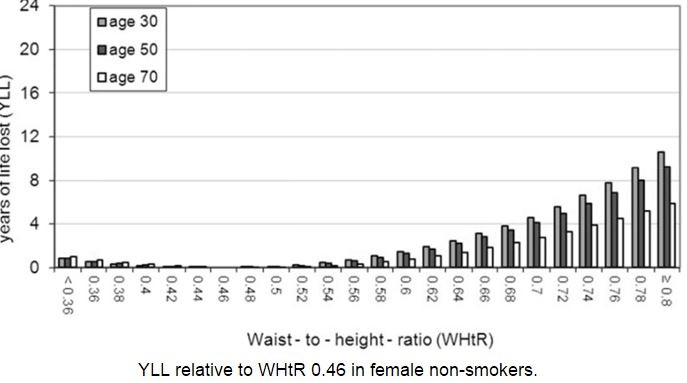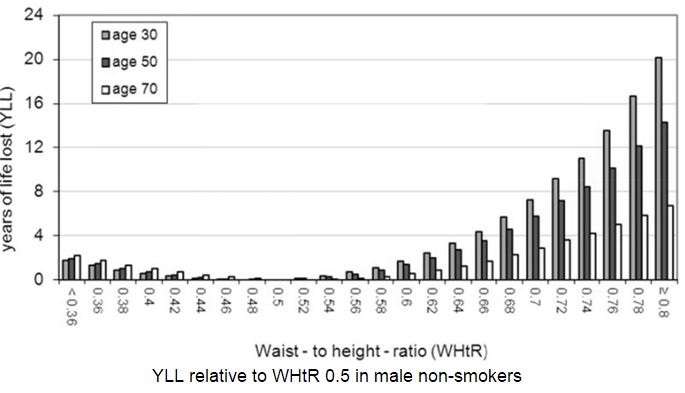13. Waist to height ratio (WHtR)
Michael Mosley has emphasized that the fat accumulating around the belly is an important indicator of cardiovascular risk even if you are not overtly fat or obese. That's because visceral fat, which accumulates in the abdomen, is the worst kind of fat as it increases inflammation and raises the risk of diabetes.
In his 5:2 Fast Diet book Mosley states that you should aim for a waist measurement that is half your height, or less. The waist measurement he refers to is not the same thing as your trouser or skirt size which will probably underestimate your true waist size. For this measurement to be accurate you need to place the tape measure halfway between the bottom of your lowest rib and the top of your hip. On me that point is about one inch above the belly button and corresponds with what looks like the visual minimum for the waist. You also need to relax and breathe out - no holding anything in! The set of skin fold calipers I recommended earlier in the blog came with a sprung loaded tape measure that make this measurement easy and consistent since the tape measure is tightened with an even spring force.
I am 175cm tall and a year ago my waist, by this measure, was 91.9cm (36.2") which have me a WHtR of 0.53. Six months later, and minus 20kg of fat, my waist was down to 81.5cm (32.1") giving me a WHtR of 0.47. One year later and my waist size is unchanged at 81.5cm, even although my weight has been increased by the addition of about 6kg of lean muscle mass, which means that belly fat has not increased at all. I knew that anyway because I still check body fat every couple of weeks with my skin fold calipers. What is interesting to note here is that the WHtR measure shows that my belly fat has remained essentially constant (actually I have lost a small amount of fat in the last 7 months, around 400g) whereas my current BMI value suggests that I have become fatter and less healthy as my BMI increased from 22.2 (= 68/1.752) to 24.3 (74.3/1.752).
That erroneous view, as I explained previously, is because BMI only measures height per kilogram squared (kg/m2). BMI measures nothing about your individual fat level because it is based on average values from large population studies which are inevitablybiased by the fact that 26% of men and women in the UK are now classified as obese. So BMI will not accurately predict your individual fat level if you are not overweight or obese or train regularly, whereas WHtR at least measures something on your body that directly relates to the level of visceral fat.
13.1 Years of Life Lost as a result of central obesity
I came across this fascinating paper recently while delving further in to Waist to Height Ratio :
https://www.ncbi.nlm.nih.gov/pmc/articles/PMC4157748/
The authors used data from non-smoking UK adults to study the effect on mortality of abdominal fat as measured by both Body Mass Index (BMI) and Waist to Height Ratio (WHtR). From their data they calculated the optimum BMI and WtHR values and then estimated the Years Lost to Life (YLL) for values of BMI and WHtR that were higher or lower than the optimum values, and they did this for adults aged 30, 50 and 70 years. Here are some of the main findings :
1. WHtR is a better predictor of Years Lost to Life (YLL) than BMI.
2. The optimum value of BMI for minimum YLL was 24 for men and 26 for women. (BMI recommendations for “healthy” have historically been stated as 18-24 although the lower limit of 18 has recently been raised to 21. However this study shows that the value for optimum life expectancy is actually situated right at the upper limit of what was formerly considered a healthy BMI. So my conclusion remains the same as before – just ignore BMI and measure your waist regularly!
3. The optimum value of WHtR for minimum YLL was 0.50 for men and 0.46 for women. Adults should aim to be at or below the optimum value.
4. The risk of increased YLL rises quite steeply above the optimum WHtR. It also rises for values below the optimum value, but much less steeply, which is why they suggest that the "OK" range could be considered as 0.4 to 0.5.
5. WHtR values between 0.5 and 0.6 signify that you should "Consider Action", while values above 0.6 signify "Take Action". To put this in context for a male of my height (175cm) the "Consider Action" threshold starts at a waist circumference of 87.5cm (34.5") and the "Take Action" threshold at 105cm (41.3").
There is a lot more information in the original paper but here are two charts which show the relationship between WHtR and Years Lost to Life for both female and male non-smokers :


